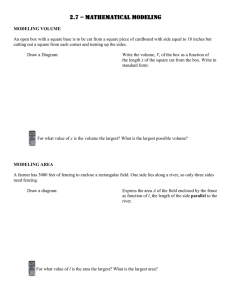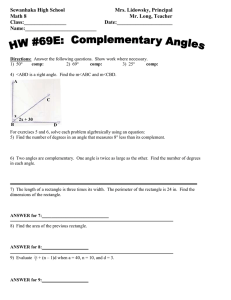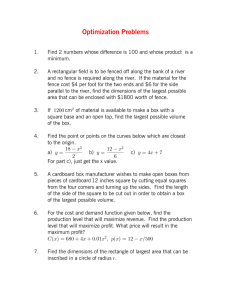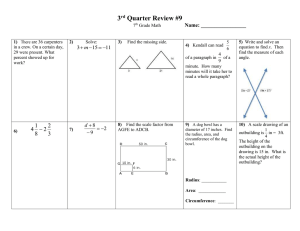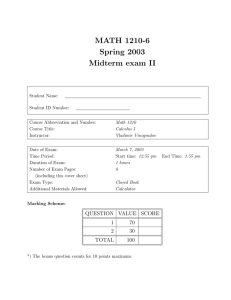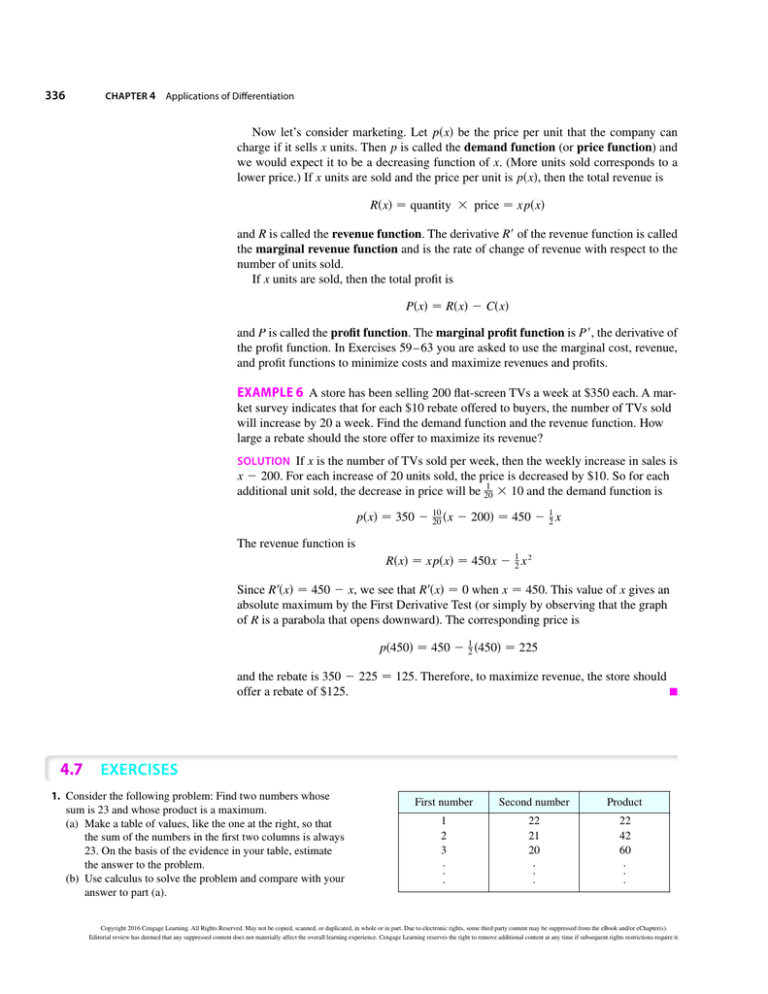
336
CHAPTER 4
Applications of Differentiation
Now let’s consider marketing. Let psxd be the price per unit that the company can
charge if it sells x units. Then p is called the demand function (or price function) and
we would expect it to be a decreasing function of x. (More units sold corresponds to a
lower price.) If x units are sold and the price per unit is psxd, then the total revenue is
Rsxd − quantity 3 price − xpsxd
and R is called the revenue function. The derivative R9 of the revenue function is called
the marginal revenue function and is the rate of change of revenue with respect to the
number of units sold.
If x units are sold, then the total profit is
Psxd − Rsxd 2 Csxd
and P is called the profit function. The marginal profit function is P9, the derivative of
the profit function. In Exercises 59 –63 you are asked to use the marginal cost, revenue,
and profit functions to minimize costs and maximize revenues and profits.
EXAMPLE 6 A store has been selling 200 flat-screen TVs a week at $350 each. A market survey indicates that for each $10 rebate offered to buyers, the number of TVs sold
will increase by 20 a week. Find the demand function and the revenue function. How
large a rebate should the store offer to maximize its revenue?
SOLUTION If x is the number of TVs sold per week, then the weekly increase in sales is
x 2 200. For each increase of 20 units sold, the price is decreased by $10. So for each
1
additional unit sold, the decrease in price will be 20
3 10 and the demand function is
1
psxd − 350 2 10
20 sx 2 200d − 450 2 2 x
The revenue function is
Rsxd − xpsxd − 450x 2 12 x 2
Since R9sxd − 450 2 x, we see that R9sxd − 0 when x − 450. This value of x gives an
absolute maximum by the First Derivative Test (or simply by observing that the graph
of R is a parabola that opens downward). The corresponding price is
ps450d − 450 2 12 s450d − 225
and the rebate is 350 2 225 − 125. Therefore, to maximize revenue, the store should
offer a rebate of $125.
Q
1. Consider the following problem: Find two numbers whose
sum is 23 and whose product is a maximum.
(a) Make a table of values, like the one at the right, so that
the sum of the numbers in the first two columns is always
23. On the basis of the evidence in your table, estimate
the answer to the problem.
(b) Use calculus to solve the problem and compare with your
answer to part (a).
First number
Second number
Product
1
2
3
.
.
.
22
21
20
.
.
.
22
42
60
.
.
.
Copyright 2016 Cengage Learning. All Rights Reserved. May not be copied, scanned, or duplicated, in whole or in part. Due to electronic rights, some third party content may be suppressed from the eBook and/or eChapter(s).
Editorial review has deemed that any suppressed content does not materially affect the overall learning experience. Cengage Learning reserves the right to remove additional content at any time if subsequent rights restrictions require it.
SECTION 4.7
2. Find two numbers whose difference is 100 and whose product
is a minimum.
3. Find two positive numbers whose product is 100 and whose
sum is a minimum.
4. The sum of two positive numbers is 16. What is the smallest
possible value of the sum of their squares?
5. What is the maximum vertical distance between the line
y − x 1 2 and the parabola y − x 2 for 21 < x < 2?
6. What is the minimum vertical distance between the parabolas
y − x 2 1 1 and y − x 2 x 2 ?
7. Find the dimensions of a rectangle with perimeter 100 m
whose area is as large as possible.
8. Find the dimensions of a rectangle with area 1000 m2 whose
perimeter is as small as possible.
9. A model used for the yield Y of an agricultural crop as a
function of the nitrogen level N in the soil (measured in
appropriate units) is
Y−
kN
1 1 N2
where k is a positive constant. What nitrogen level gives the
best yield?
10. The rate sin mg carbonym 3yhd at which photosynthesis takes
place for a species of phytoplankton is modeled by the
function
P−
100 I
I2 1 I 1 4
where I is the light intensity (measured in thousands of footcandles). For what light intensity is P a maximum?
11. Consider the following problem: A farmer with 750 ft of
fencing wants to enclose a rectangular area and then divide
it into four pens with fencing parallel to one side of the
rectangle. What is the largest possible total area of the
four pens?
(a) Draw several diagrams illustrating the situation, some
with shallow, wide pens and some with deep, narrow pens.
Find the total areas of these configurations. Does it appear
that there is a maximum area? If so, estimate it.
(b) Draw a diagram illustrating the general situation. Introduce notation and label the diagram with your symbols.
(c) Write an expression for the total area.
(d) Use the given information to write an equation that
relates the variables.
(e) Use part (d) to write the total area as a function of one
variable.
(f ) Finish solving the problem and compare the answer with
your estimate in part (a).
12. Consider the following problem: A box with an open top is to
be constructed from a square piece of cardboard, 3 ft wide, by
cutting out a square from each of the four corners and bend-
Optimization Problems
337
ing up the sides. Find the largest volume that such a box can
have.
(a) Draw several diagrams to illustrate the situation, some
short boxes with large bases and some tall boxes with
small bases. Find the volumes of several such boxes.
Does it appear that there is a maximum volume? If so,
estimate it.
(b) Draw a diagram illustrating the general situation. Introduce notation and label the diagram with your symbols.
(c) Write an expression for the volume.
(d) Use the given information to write an equation that
relates the variables.
(e) Use part (d) to write the volume as a function of one
variable.
(f ) Finish solving the problem and compare the answer with
your estimate in part (a).
13. A farmer wants to fence in an area of 1.5 million square feet
in a rectangular field and then divide it in half with a fence
parallel to one of the sides of the rectangle. How can he do
this so as to minimize the cost of the fence?
14. A box with a square base and open top must have a volume of
32,000 cm3. Find the dimensions of the box that minimize the
amount of material used.
15. If 1200 cm2 of material is available to make a box with a
square base and an open top, find the largest possible volume
of the box.
16. A rectangular storage container with an open top is to have
a volume of 10 m3. The length of its base is twice the width.
Material for the base costs $10 per square meter. Material for
the sides costs $6 per square meter. Find the cost of materials
for the cheapest such container.
17. Do Exercise 16 assuming the container has a lid that is made
from the same material as the sides.
18. A farmer wants to fence in a rectangular plot of land adjacent
to the north wall of his barn. No fencing is needed along the
barn, and the fencing along the west side of the plot is shared
with a neighbor who will split the cost of that portion of the
fence. If the fencing costs $20 per linear foot to install and
the farmer is not willing to spend more than $5000, find the
dimensions for the plot that would enclose the most area.
19. If the farmer in Exercise 18 wants to enclose 8000 square
feet of land, what dimensions will minimize the cost of
the fence?
20. (a) Show that of all the rectangles with a given area, the one
with smallest perimeter is a square.
(b) Show that of all the rectangles with a given perimeter, the
one with greatest area is a square.
21. Find the point on the line y − 2x 1 3 that is closest to the
origin.
22. Find the point on the curve y − sx that is closest to the
point s3, 0d.
Copyright 2016 Cengage Learning. All Rights Reserved. May not be copied, scanned, or duplicated, in whole or in part. Due to electronic rights, some third party content may be suppressed from the eBook and/or eChapter(s).
Editorial review has deemed that any suppressed content does not materially affect the overall learning experience. Cengage Learning reserves the right to remove additional content at any time if subsequent rights restrictions require it.
338
CHAPTER 4
Applications of Differentiation
23. Find the points on the ellipse 4x 2 1 y 2 − 4 that are farthest
away from the point s1, 0d.
; 24. Find, correct to two decimal places, the coordinates of the
point on the curve y − sin x that is closest to the point s4, 2d.
25. Find the dimensions of the rectangle of largest area that can
be inscribed in a circle of radius r.
26. Find the area of the largest rectangle that can be inscribed in
the ellipse x 2ya 2 1 y 2yb 2 − 1.
27. Find the dimensions of the rectangle of largest area that can
be inscribed in an equilateral triangle of side L if one side of
the rectangle lies on the base of the triangle.
39. If you are offered one slice from a round pizza (in other
words, a sector of a circle) and the slice must have a
perimeter of 32 inches, what diameter pizza will reward
you with the largest slice?
40. A fence 8 ft tall runs parallel to a tall building at a distance
of 4 ft from the building. What is the length of the shortest
ladder that will reach from the ground over the fence to
the wall of the building?
41. A cone-shaped drinking cup is made from a circular piece
of paper of radius R by cutting out a sector and joining
the edges CA and CB. Find the maximum capacity of
such a cup.
A
B
28. Find the area of the largest trapezoid that can be inscribed
in a circle of radius 1 and whose base is a diameter of the
circle.
R
C
29. Find the dimensions of the isosceles triangle of largest area
that can be inscribed in a circle of radius r.
30. If the two equal sides of an isosceles triangle have length a,
find the length of the third side that maximizes the area of
the triangle.
31. A right circular cylinder is inscribed in a sphere of radius r.
Find the largest possible volume of such a cylinder.
32. A right circular cylinder is inscribed in a cone with height h
and base radius r. Find the largest possible volume of such
a cylinder.
33. A right circular cylinder is inscribed in a sphere of radius r.
Find the largest possible surface area of such a cylinder.
34. A Norman window has the shape of a rectangle surmounted by a semicircle. (Thus the diameter of the
semicircle is equal to the width of the rectangle. See Exercise 1.1.62.) If the perimeter of the window is 30 ft, find
the dimensions of the window so that the greatest possible
amount of light is admitted.
35. The top and bottom margins of a poster are each 6 cm and
the side margins are each 4 cm. If the area of printed material on the poster is fixed at 384 cm2, find the dimensions of
the poster with the smallest area.
36. A poster is to have an area of 180 in2 with 1-inch margins at
the bottom and sides and a 2-inch margin at the top. What
dimensions will give the largest printed area?
37. A piece of wire 10 m long is cut into two pieces. One piece
is bent into a square and the other is bent into an equilateral
triangle. How should the wire be cut so that the total area
enclosed is (a) a maximum? (b) A minimum?
38. Answer Exercise 37 if one piece is bent into a square and
the other into a circle.
42. A cone-shaped paper drinking cup is to be made to hold
27 cm3 of water. Find the height and radius of the cup that
will use the smallest amount of paper.
43. A cone with height h is inscribed in a larger cone with
height H so that its vertex is at the center of the base of
the larger cone. Show that the inner cone has maximum
volume when h − 13 H.
44. An object with weight W is dragged along a horizontal
plane by a force acting along a rope attached to the object.
If the rope makes an angle with a plane, then the magnitude of the force is
F−
W
sin 1 cos where is a constant called the coefficient of friction. For
what value of is F smallest?
45. If a resistor of R ohms is connected across a battery of E
volts with internal resistance r ohms, then the power (in
watts) in the external resistor is
P−
E 2R
sR 1 rd 2
If E and r are fixed but R varies, what is the maximum
value of the power?
46. For a fish swimming at a speed v relative to the water,
the energy expenditure per unit time is proportional to
v 3. It is believed that migrating fish try to minimize the
total energy required to swim a fixed distance. If the fish
are swimming against a current u su , vd, then the time
Copyright 2016 Cengage Learning. All Rights Reserved. May not be copied, scanned, or duplicated, in whole or in part. Due to electronic rights, some third party content may be suppressed from the eBook and/or eChapter(s).
Editorial review has deemed that any suppressed content does not materially affect the overall learning experience. Cengage Learning reserves the right to remove additional content at any time if subsequent rights restrictions require it.
SECTION 4.7
required to swim a distance L is Lysv 2 ud and the total
energy E required to swim the distance is given by
Esvd − av 3 ?
L
47. In a beehive, each cell is a regular hexagonal prism, open
at one end with a trihedral angle at the other end as in the
figure. It is believed that bees form their cells in such a
way as to minimize the surface area for a given side length
and height, thus using the least amount of wax in cell
construction. Examination of these cells has shown that
the measure of the apex angle is amazingly consistent.
Based on the geometry of the cell, it can be shown that the
surface area S is given by
S − 6sh 2 32 s 2 cot 1 (3s 2s3 y2) csc where s, the length of the sides of the hexagon, and h, the
height, are constants.
(a) Calculate dSyd.
(b) What angle should the bees prefer?
(c) Determine the minimum surface area of the cell (in
terms of s and h).
Note: Actual measurements of the angle in beehives
have been made, and the measures of these angles seldom
differ from the calculated value by more than 28.
trihedral
angle ¨
B
A
¨
2
C
2
51. An oil refinery is located on the north bank of a straight
river that is 2 km wide. A pipeline is to be constructed from
the refinery to storage tanks located on the south bank of
the river 6 km east of the refinery. The cost of laying pipe is
$400,000ykm over land to a point P on the north bank and
$800,000ykm under the river to the tanks. To minimize the
cost of the pipeline, where should P be located?
; 52. Suppose the refinery in Exercise 51 is located 1 km north
of the river. Where should P be located?
53. The illumination of an object by a light source is directly
proportional to the strength of the source and inversely proportional to the square of the distance from the source.
If two light sources, one three times as strong as the other,
are placed 10 ft apart, where should an object be placed
on the line between the sources so as to receive the least
illumination?
54. Find an equation of the line through the point s3, 5d that cuts
off the least area from the first quadrant.
55. Let a and b be positive numbers. Find the length of the shortest line segment that is cut off by the first quadrant and passes
through the point sa, bd.
56. At which points on the curve y − 1 1 40x 3 2 3x 5 does the
tangent line have the largest slope?
h
b
s
339
opposite A on the other side of the lake in the shortest
possible time (see the figure). She can walk at the rate of
4 miyh and row a boat at 2 miyh. How should she proceed?
v2u
where a is the proportionality constant.
(a) Determine the value of v that minimizes E.
(b) Sketch the graph of E.
Note: This result has been verified experimentally; migrating fish swim against a current at a speed 50% greater than
the current speed.
rear
of cell
Optimization Problems
front
of cell
48. A boat leaves a dock at 2:00 pm and travels due south at a
speed of 20 kmyh. Another boat has been heading due east
at 15 kmyh and reaches the same dock at 3:00 pm. At what
time were the two boats closest together?
49. Solve the problem in Example 4 if the river is 5 km wide
and point B is only 5 km downstream from A.
50. A woman at a point A on the shore of a circular lake with
radius 2 mi wants to arrive at the point C diametrically
57. What is the shortest possible length of the line segment that
is cut off by the first quadrant and is tangent to the curve
y − 3yx at some point?
58. What is the smallest possible area of the triangle that is cut
off by the first quadrant and whose hypotenuse is tangent to
the parabola y − 4 2 x 2 at some point?
59. (a) If Csxd is the cost of producing x units of a commodity,
then the average cost per unit is csxd − Csxdyx. Show
that if the average cost is a minimum, then the marginal
cost equals the average cost.
(b) If Csxd − 16,000 1 200x 1 4x 3y2, in dollars, find (i) the
cost, average cost, and marginal cost at a production level
of 1000 units; (ii) the production level that will minimize
the average cost; and (iii) the minimum average cost.
Copyright 2016 Cengage Learning. All Rights Reserved. May not be copied, scanned, or duplicated, in whole or in part. Due to electronic rights, some third party content may be suppressed from the eBook and/or eChapter(s).
Editorial review has deemed that any suppressed content does not materially affect the overall learning experience. Cengage Learning reserves the right to remove additional content at any time if subsequent rights restrictions require it.
340
CHAPTER 4
Applications of Differentiation
60. (a) Show that if the profit Psxd is a maximum, then the
marginal revenue equals the marginal cost.
(b) If Csxd − 16,000 1 500x 2 1.6x 2 1 0.004x 3 is the cost
function and psxd − 1700 2 7x is the demand function,
find the production level that will maximize profit.
61. A baseball team plays in a stadium that holds 55,000 spectators. With ticket prices at $10, the average attendance had
been 27,000. When ticket prices were lowered to $8, the
average attendance rose to 33,000.
(a) Find the demand function, assuming that it is linear.
(b) How should ticket prices be set to maximize revenue?
62. During the summer months Terry makes and sells necklaces
on the beach. Last summer he sold the necklaces for $10
each and his sales averaged 20 per day. When he increased
the price by $1, he found that the average decreased by two
sales per day.
(a) Find the demand function, assuming that it is linear.
(b) If the material for each necklace costs Terry $6, what
should the selling price be to maximize his profit?
63. A retailer has been selling 1200 tablet computers a week
at $350 each. The marketing department estimates that an
additional 80 tablets will sell each week for every $10 that
the price is lowered.
(a) Find the demand function.
(b) What should the price be set at in order to maximize
revenue?
(c) If the retailer’s weekly cost function is
Csxd − 35,000 1 120x
what price should it choose in order to maximize its
profit?
64. A company operates 16 oil wells in a designated area. Each
pump, on average, extracts 240 barrels of oil daily. The company can add more wells but every added well reduces the
average daily ouput of each of the wells by 8 barrels. How
many wells should the company add in order to maximize
daily production?
65. Show that of all the isosceles triangles with a given perimeter, the one with the greatest area is equilateral.
66. Consider the situation in Exercise 51 if the cost of laying
pipe under the river is considerably higher than the cost of
laying pipe over land ($400,000ykm). You may suspect that
in some instances, the minimum distance possible under the
river should be used, and P should be located 6 km from the
refinery, directly across from the storage tanks. Show that this
is never the case, no matter what the “under river” cost is.
x2
y2
67. Consider the tangent line to the ellipse 2 1 2 − 1
a
b
at a point s p, qd in the first quadrant.
(a) Show that the tangent line has x-intercept a 2yp and
y-intercept b 2yq.
(b) Show that the portion of the tangent line cut off by the
coordinate axes has minimum length a 1 b.
(c) Show that the triangle formed by the tangent line and the
coordinate axes has minimum area ab.
CAS
68. The frame for a kite is to be made from six pieces of wood.
The four exterior pieces have been cut with the lengths indicated in the figure. To maximize the area of the kite, how long
should the diagonal pieces be?
a
b
a
b
; 69. A point P needs to be located somewhere on the line AD so
that the total length L of cables linking P to the points A, B.
and C is minimized (see the figure). Express L as a function
of x − AP and use the graphs of L and dLydx to estimate
the minimum value of L.
| |
A
P
5m
2m
3m
C
D
B
70. The graph shows the fuel consumption c of a car (measured
in gallons per hour) as a function of the speed v of the car.
At very low speeds the engine runs inefficiently, so initially c
decreases as the speed increases. But at high speeds the fuel
consumption increases. You can see that csvd is minimized for
this car when v < 30 miyh. However, for fuel efficiency, what
must be minimized is not the consumption in gallons per hour
but rather the fuel consumption in gallons per mile. Let’s call
this consumption G. Using the graph, estimate the speed at
which G has its minimum value.
c
0
20
40
60
√
71. Let v1 be the velocity of light in air and v2 the velocity of light
in water. According to Fermat’s Principle, a ray of light will
travel from a point A in the air to a point B in the water by a
path ACB that minimizes the time taken. Show that
sin 1
v1
−
sin 2
v2
Copyright 2016 Cengage Learning. All Rights Reserved. May not be copied, scanned, or duplicated, in whole or in part. Due to electronic rights, some third party content may be suppressed from the eBook and/or eChapter(s).
Editorial review has deemed that any suppressed content does not materially affect the overall learning experience. Cengage Learning reserves the right to remove additional content at any time if subsequent rights restrictions require it.
SECTION 4.7
where 1 (the angle of incidence) and 2 (the angle of refraction) are as shown. This equation is known as Snell’s Law.
A
¨¡
75. An observer stands at a point P, one unit away from a
track. Two runners start at the point S in the figure and run
along the track. One runner runs three times as fast as the
other. Find the maximum value of the observer’s angle of
sight between the runners.
C
P
¨
¨™
1
B
72. Two vertical poles PQ and ST are secured by a rope PRS
going from the top of the first pole to a point R on the ground
between the poles and then to the top of the second pole as in
the figure. Show that the shortest length of such a rope occurs
when 1 − 2 .
P
S
S
76. A rain gutter is to be constructed from a metal sheet of
width 30 cm by bending up one-third of the sheet on each
side through an angle . How should be chosen so that
the gutter will carry the maximum amount of water?
¨
¨™
¨¡
Q
R
341
Optimization Problems
¨
10 cm
10 cm
10 cm
T
73. The upper right-hand corner of a piece of paper, 12 in. by
8 in., as in the figure, is folded over to the bottom edge. How
would you fold it so as to minimize the length of the fold?
In other words, how would you choose x to minimize y?
77. Where should the point P be chosen on the line segment
AB so as to maximize the angle ?
B
P
2
¨
3
12
y
x
5
A
8
74. A steel pipe is being carried down a hallway 9 ft wide. At
the end of the hall there is a right-angled turn into a narrower
hallway 6 ft wide. What is the length of the longest pipe that
can be carried horizontally around the corner?
78. A painting in an art gallery has height h and is hung so that
its lower edge is a distance d above the eye of an observer
(as in the figure). How far from the wall should the
observer stand to get the best view? (In other words, where
should the observer stand so as to maximize the angle subtended at his eye by the painting?)
h
6
¨
d
¨
9
79. Find the maximum area of a rectangle that can be circumscribed about a given rectangle with length L and width W.
[Hint: Express the area as a function of an angle .]
Copyright 2016 Cengage Learning. All Rights Reserved. May not be copied, scanned, or duplicated, in whole or in part. Due to electronic rights, some third party content may be suppressed from the eBook and/or eChapter(s).
Editorial review has deemed that any suppressed content does not materially affect the overall learning experience. Cengage Learning reserves the right to remove additional content at any time if subsequent rights restrictions require it.
342
CHAPTER 4
Applications of Differentiation
80. The blood vascular system consists of blood vessels (arteries,
arterioles, capillaries, and veins) that convey blood from the
heart to the organs and back to the heart. This system should
work so as to minimize the energy expended by the heart in
pumping the blood. In particular, this energy is reduced when
the resistance of the blood is lowered. One of Poiseuille’s
Laws gives the resistance R of the blood as
R−C
L
r4
where L is the length of the blood vessel, r is the radius, and
C is a positive constant determined by the viscosity of the
blood. (Poiseuille established this law experimentally, but it
also follows from Equation 8.4.2.) The figure shows a main
blood vessel with radius r1 branching at an angle into a
smaller vessel with radius r 2.
fly in order to minimize the total energy expended in
returning to its nesting area?
(b) Let W and L denote the energy (in joules) per kilometer flown over water and land, respectively. What
would a large value of the ratio WyL mean in terms
of the bird’s flight? What would a small value mean?
Determine the ratio WyL corresponding to the minimum expenditure of energy.
(c) What should the value of WyL be in order for the bird
to fly directly to its nesting area D? What should the
value of WyL be for the bird to fly to B and then along
the shore to D?
(d) If the ornithologists observe that birds of a certain
species reach the shore at a point 4 km from B, how
many times more energy does it take a bird to fly over
water than over land?
C
island
r™
b
vascular
branching
A
5 km
r¡
C
¨
D
B
B
nest
13 km
a
(a) Use Poiseuille’s Law to show that the total resistance of
the blood along the path ABC is
R−C
S
D
a 2 b cot b csc 1
r14
r24
where a and b are the distances shown in the figure.
(b) Prove that this resistance is minimized when
cos −
r24
r14
(c) Find the optimal branching angle (correct to the nearest
degree) when the radius of the smaller blood vessel is
two-thirds the radius of the larger vessel.
81. Ornithologists have determined that some species of birds
tend to avoid flights over large bodies of water during daylight
hours. It is believed that more energy is required to fly over
water than over land because air generally rises over land and
falls over water during the day. A bird with these tendencies
is released from an island that is 5 km from the nearest point
B on a straight shoreline, flies to a point C on the shoreline,
and then flies along the shoreline to its nesting area D. Assume
that the bird instinctively chooses a path that will minimize its
energy expenditure. Points B and D are 13 km apart.
(a) In general, if it takes 1.4 times as much energy to fly over
water as it does over land, to what point C should the bird
; 82. Two light sources of identical strength are placed 10 m
apart. An object is to be placed at a point P on a line ,,
parallel to the line joining the light sources and at a distance d meters from it (see the figure). We want to locate
P on , so that the intensity of illumination is minimized.
We need to use the fact that the intensity of illumination
for a single source is directly proportional to the strength
of the source and inversely proportional to the square of
the distance from the source.
(a) Find an expression for the intensity Isxd at the point P.
(b) If d − 5 m, use graphs of Isxd and I9sxd to show that
the intensity is minimized when x − 5 m, that is,
when P is at the midpoint of ,.
(c) If d − 10 m, show that the intensity (perhaps surprisingly) is not minimized at the midpoint.
(d) Somewhere between d − 5 m and d − 10 m there is
a transitional value of d at which the point of minimal
illumination abruptly changes. Estimate this value of d
by graphical methods. Then find the exact value of d.
P
x
d
10 m
Copyright 2016 Cengage Learning. All Rights Reserved. May not be copied, scanned, or duplicated, in whole or in part. Due to electronic rights, some third party content may be suppressed from the eBook and/or eChapter(s).
Editorial review has deemed that any suppressed content does not materially affect the overall learning experience. Cengage Learning reserves the right to remove additional content at any time if subsequent rights restrictions require it.

